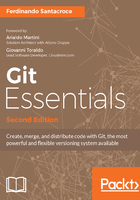
Wrapping up
It's time to summarize all the concepts illustrated since now.
An image, as they say, is worth a thousand words, so here you can find a picture representing the actual state of our repository, thanks to the git-draw tool (https://github.com/sensorflo/git-draw):

In this graphic representation, you will find a detailed diagram that represents the current structure of the newly created repository; you can see trees (yellow), blobs (white), commits (green), and all relationships between them, represented by oriented arrows.
Note how the direction of the arrow joining the commit comes from the second commit and goes to the first, or from descendant to its ancestor; it may seem a detail, but it is important that graphic representations such as these are properly indicated in order to correctly highlight the relationship that binds the commits between them (it is always the child who depends on the parent).
I just want to highlight some other things; such as:
- The two different trees refer to the same README.md blob
- There are two different blobs for the shoppingList.txt files, one containing only the banana text line and one containing banana and apple
- The second commit refers to the first
- The first commit has no parent
- There are three commits!
What the heck?!
Okay, don't panic. Look at the commit at the right of the picture, and read author and email: that was the first commit we did using the wrong user and email; after that, we amended the commit, changing the author, remember?
Well, but why is it already there? And why do we see it in this picture, but we don't see it in git log?
It's about reachability of the commit, a topic that we will talk about in the following sections.